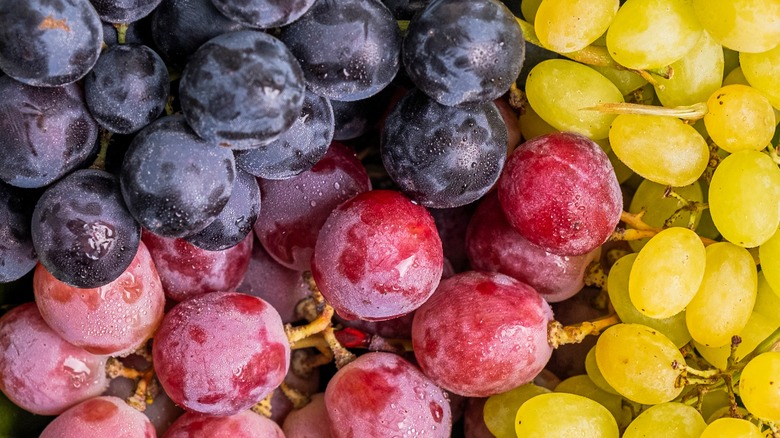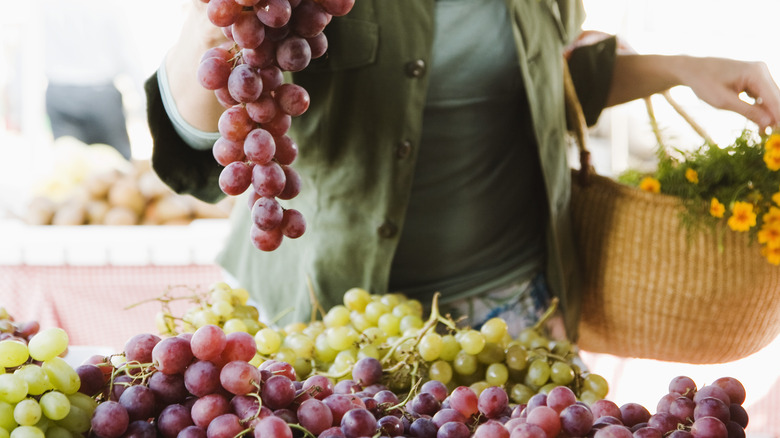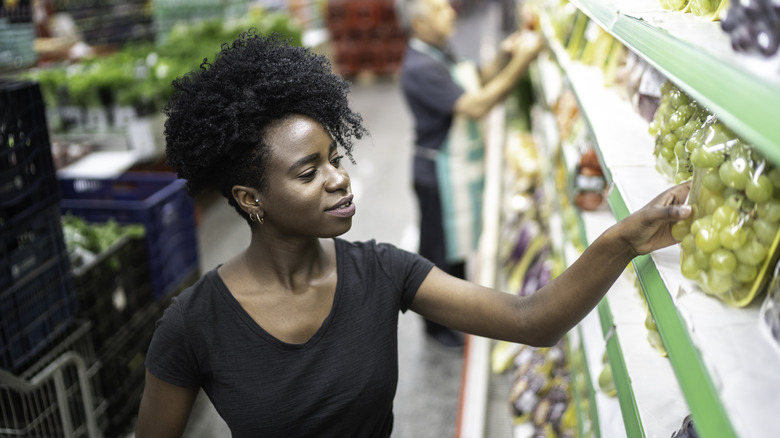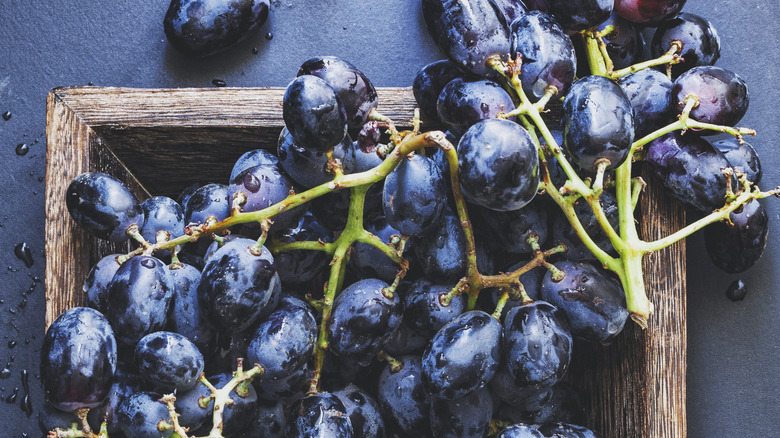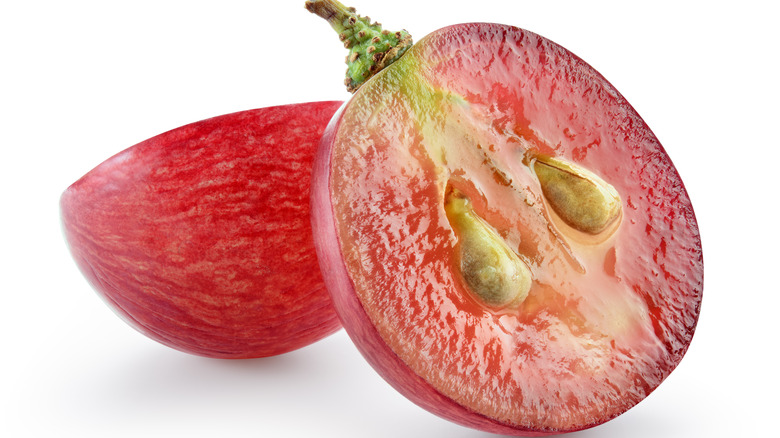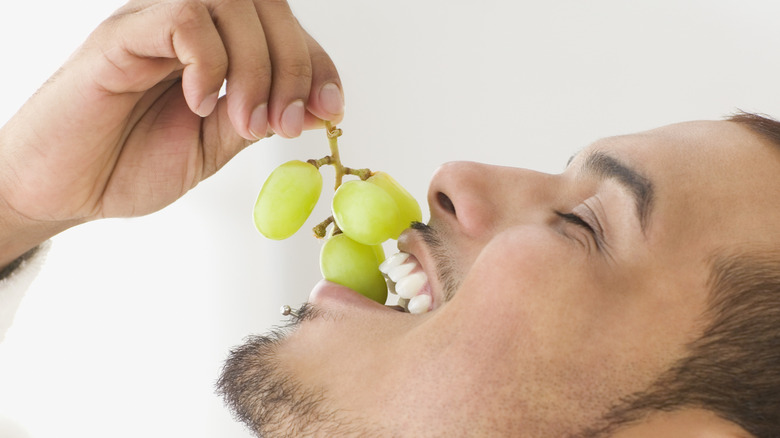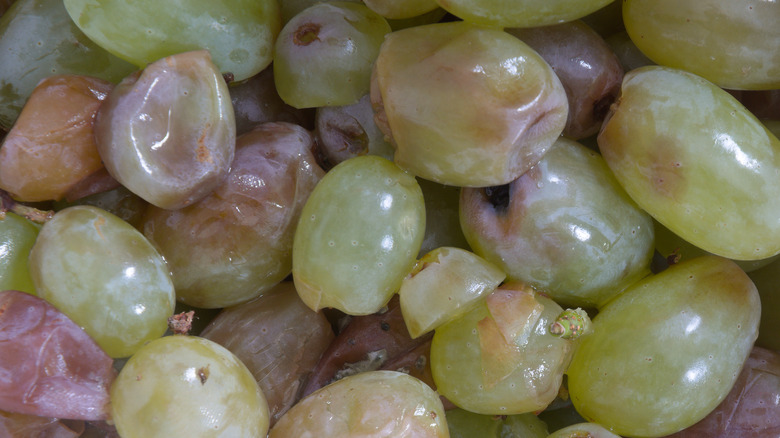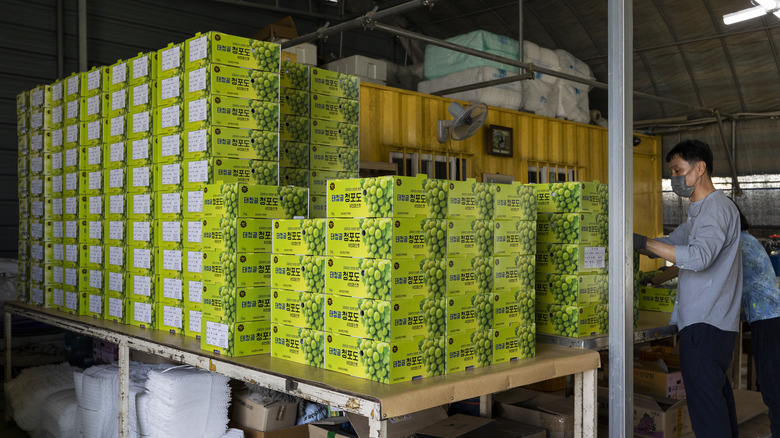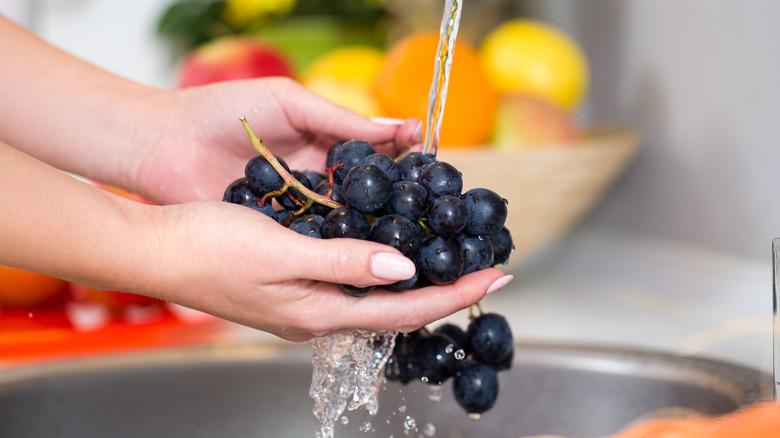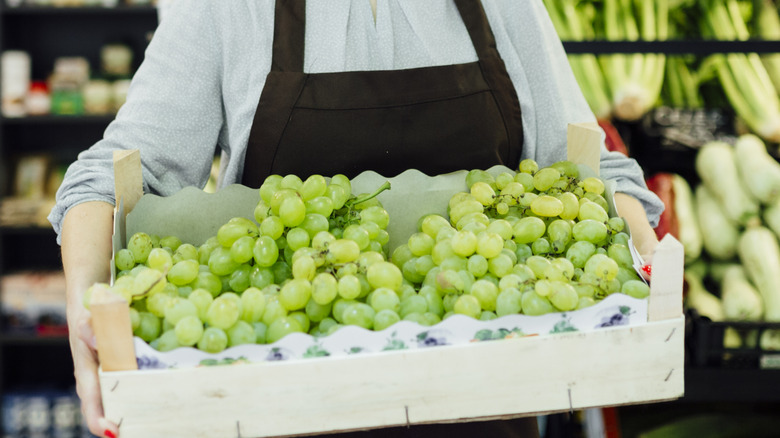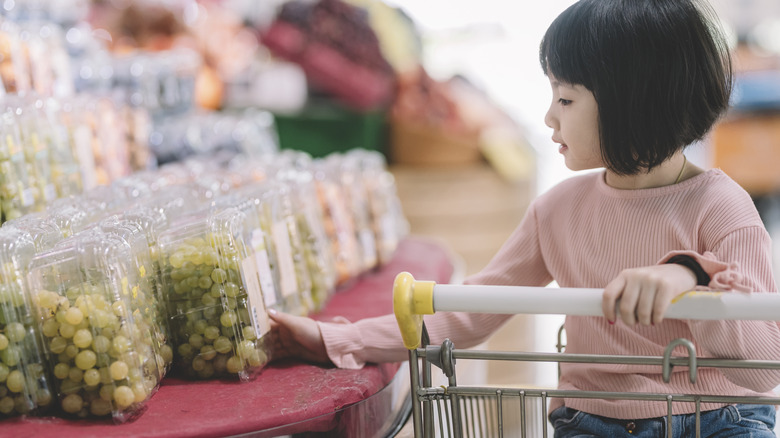Mistakes Everyone Makes When Buying Grapes
When it comes to perfect foods you can pluck right from nature, nothing compares to the glorious grape. Whether you're snacking on light, delicate green ones; rich, vibrant red ones; dark, mysterious black ones; or any of the hundreds of other varieties out there, few foods compare to grapes in terms of sheer delicious taste, texture, and overall nutritional kick.
Packed with vitamin C, potassium, fiber, and a host of disease-fighting antioxidants, grapes are incredibly good for you. Perhaps that's why we've been eating them for centuries! The history books show that ancient Egyptians, Greeks, and Romans all cultivated grapes at some point during the peak of their civilizations. Flash forward to today and grapes are just as popular as ever. We of course eat them fresh by the bowlful, but they're also essential ingredients in everything from cheese trays to salads to parfaits.
There are some tricks when it comes to buying them. They aren't just grab-and-go like dry goods. Buy the wrong bag and you could end up with a bland, bitter, sour, or shriveled bag of disappointment. Avoid these common mistakes many of us make when buying grapes.
Forgetting to check the plumpness
When it comes to buying fresh, ripe, in-season grapes, always look at the fruit's plumpness. Plumpness — or the roundness or overall shape of the grape — is one of the primary indicators of peak flavor and ripeness. A firm, round body means it's packed with juice and hasn't yet started to break down or deteriorate after being picked.
Grapes that are nice and plump — firm and round to the touch — have perfectly balanced water content for a more refreshing bite. These grapes strike the right note of sweet flavor and succulence.
Avoid grapes that are starting to turn soft or that have a slightly dull or wrinkled appearance. They may be overripe and have started to go bad. If they're too firm, with no give at all, they might have been picked before turning completely ripe and could therefore taste bland or bitter. They also won't "pop" with freshness and release a flood of juices when you bite into them. Instead, you may find them mushy, hard, or just slightly chewy and "off" in texture. Unlike bananas, grapes don't continue to ripen off the vine. Their flavor and texture will stay the same until they begin to rot, so don't buy an unripe cluster hoping it will improve over time.
The best way to measure the plumpness of the grapes you are buying is to simply roll a few back and forth between your fingertips. They should feel dense but should still yield slightly to pressure. If they're overly hard or soft, pick a different bag.
Not smelling the grapes
You may have heard that many top chefs sniff berries, melons, peaches, and citrus fruit before buying them in order to gauge their freshness. Well, you can add grapes to that list as well. They are another fruit that you should smell before buying to ensure you are getting the freshest, best-tasting produce possible.
Why is the scent of a fresh grape such a key indicator of its overall ripeness? Thank Mother Nature and the way the ripening process takes place, not just in grapes but in fruits of all types. Before they are ripe, many fruits are almost scent-free. But as they ripen, organic compounds created as part of the ripening process begin to collect in and around the surface of the fruit, giving it a fresh, sweet, fruity, and somewhat floral scent. The more these compounds build up, the riper the fruit is. (Some industries now even use computerized "electronic noses" to measure levels of these compounds during harvest!)
The scent of fresh, ripe grapes will vary depending on type. Some grapes used in wine production will have deep, rich, or even spicy and earthy aromas. For fresh table grapes, you should be looking for a light, sweet, melon-like, almost musky scent. Avoid grapes with hints of sourness or vinegar-like scents, or those that are overpoweringly sweet-smelling — those smells mean the grapes may have already begun to ferment and spoil.
Not checking the stem
Once you've tested the firmness and scent of the grapes you are considering buying, it's time for a quick inspection of the stem. Even though you won't be eating the grape stem itself, the stem on a bunch of grapes can yield countless clues as to the overall quality and freshness of any grapes you buy. Don't make the mistake of ignoring this crucial quality indicator.
Start by looking at the color of the stem itself. The stem on fresh, recently picked grapes should be green and flexible. If the stem is crisp or brown or woody, that means the grapes have been picked long ago enough that their stem has had time to completely dry out. Even if the grapes themselves look OK now, it means they are far from fresh and will likely spoil quickly when you get them home.
Next, press the stem a bit between your fingernails. Is it moist? If so, that is a good clue that your grapes will be moist as well. Dry, shriveled stems typically mean that the grapes still connected to that stem are past their prime.
Finally, consider the firmness of the stem. It should be tough and somewhat resistant to tearing. If the stem falls apart easily or the grapes easily fall from the stem, that's another indicator that the grapes you are looking at are overripe and you'd be better off selecting a different bag.
Not considering the variety of the grape
Ever see a beautiful bag of grapes hanging out at your local market or grocery store, buy it based on sight alone, and then get home ready to eat it — only to discover that those delicious grapes you were so anxious to devour all contain seeds? It's a common blunder many of us make when buying grapes. As we already warned, you can't just '"grab and go" when buying grapes.
Some amazing grapes do contain seeds, so you shouldn't give up on seeded grapes entirely. Just be sure to always check the variety you are buying to avoid disappointment later on.
For those of us who don't know our grape varieties, here's a quick primer on the varieties you see in most stores:
- Thompson or Sultana grapes are small- to medium-sized, greenish-yellow, and seedless
- Niagara (aka white grapes) are medium-sized and seedless
- Flame and Crimson grapes are both medium-sized, reddish-purple, and seedless
- Red Globe grapes are large and round (hence the name) and have seeds
- Concord grapes are smaller, tend to be dark blue, and have a large seed
- Muscat grapes are medium-sized, golden yellow, and seeded
Not tasting a grape before you buy
Is it OK to taste a grape in the grocery store before you buy, or is it theft? Most sources say it's completely fine, but a few sticklers insist that if you don't wind up taking the particular bag you sample from, it's technically theft. Whichever side of the discussion you land on, there's no debating the fact that tasting a "sample" grape remains the best and overall most effective way to measure the freshness of any bunch of grapes you're considering buying.
Should you choose to try a grape before your next purchase — no judgment! — you'll want to look for fruit that is sweet, juicy, and most importantly crisp when you bite into it. The flavor should explode into your mouth in a wave of floral richness. The grape you try should taste sweet, of course, but refreshing and satisfying, with a pleasant hint of acidity and a slightly tart aftertaste. If the grape tastes sour, bitter, or bland, it's likely not as fresh as it should be, so consider a different bag. If the grape is dry or lacks juice, it may be old or have been stored improperly and you should definitely consider a different option.
Also, if you can't rinse your sample grape before trying it, at least wipe it down as best you can before you bite in.
Buying grapes with brown spots
Even if the grapes you are considering buying don't look that gnarly, always spend a bit of time checking to see if the fruit you are about to buy has any significant brown spots or discoloration. Not doing so almost guarantees you are going to end up throwing away at least some of your purchase. Look over the full bag; sometimes one fine-looking bunch will have a few hidden duds.
In most cases, the brown spots on grapes are bruises. Grapes are delicate and any sort of mishandling in growing, harvesting, or transportation of the fruit can cause it to develop this sort of brown spot or bruise. Brown spots can also be caused by fungal infections, insects, or premature spoilage. Whatever the cause, it's generally not a good idea to buy grapes with brown spots, as they tend to be less fresh and have a much shorter shelf life than grapes without this sort of damage.
The good news is that in most cases, these brown spotted grapes are completely edible. If you find a lot on grapes you've already bought, you just need to consume them as quickly as possible before they have time to get worse. If you find a couple that have become too soft or mushy to handle easily, throw them away so they don't spoil the entire bunch.
Ignoring where the grapes come from
Locally grown produce is almost always fresher and better-tasting than imports, and that's as true for grapes as it is for anything else you can buy in your local market. When looking for great-tasting, quality grapes, it's a mistake not to consider where the grapes you are looking at come from before you buy them.
Luckily, grocery stores are here to help you out. Most should have clear, easy-to-spot language either on the grape's packaging or on the display telling you where the grapes you are looking at came from. Are they from your state or a neighboring region? Or are they imported from another country? The closer the grapes originated to where you live, the better they will likely be.
Imagine: the grapes could have just been harvested and driven across state lines. Or, they may have been harvested, packed onto a train or boat, and spent days in transit and customs before reaching your local store. The locally grown grapes were also likely picked at the peak of ripeness, while the grapes that need extra transportation were likely picked before peak ripeness to ensure they would survive the trip.
If you have limited options, imported grapes are usually serviceable, but otherwise buying tasty locally grown grapes is a no-brainer.
Eating your grapes without washing them
It can be incredibly tempting to dig into that big bag of fresh, beautiful grapes as soon as you get them home, but don't do it. It's never a good idea to eat grapes you've bought in any market without washing them first. Besides dirt, dust, and debris, grapes can also be contaminated with human waste, harmful bacteria, pesticides, chemicals, and other residue that may be harmful to your health. In fact, grapes are one of the 12 "dirtiest" fruits and vegetables you can buy, according to some studies.
As you'd expect, most of that "dirt" comes from being grown outdoors or gets picked up through the harvesting and transportation process. The best way to clean them is to rinse them under cold running water for at least 30 seconds. If you're feeling extra cautious, you can also use a vegetable brush to lightly scrub their skin, removing any dirt or residue stuck to their surface. Be sure to scrub lightly to avoid damaging that fragile skin. Don't wash your grapes until just before you plan to eat them. Rinsing fruit and then putting it back into the fridge wet promotes mold growth and will speed up how quickly your grapes go bad.
Buying too many grapes
Whether the store is having a sale and the grapes are cheap, or they just look so delicious you feel the need to load up, it's never a good idea to buy grapes in bulk unless you have a specific plan for using them up quickly. Sure, it might seem like a convenient and cost-saving idea, but if you're like most of the country, you're inevitably going to end up throwing at least some of those grapes away because they spoil before you can use them.
Like fresh berries, the biggest problem with grapes is that they have a relatively short shelf life compared to other produce. Most will only last in the fridge for a few days before they start breaking down and going bad. Combine this with their incredibly delicate skin and their susceptibility to mold when exposed to too much moisture, and they end up being one of the most common sources of food waste. (Some estimates suggest that up to a quarter of grapes sold in the country end up in landfills because they go bad before someone has the chance to eat them.)
Already have surplus grapes at home that you aren't going to be able to get to in time? Toss them in the freezer! Rinsed, de-stemmed frozen grapes are a great summer snack. You can also use your extra grapes to make homemade grape juice or jam — it's easier than you'd think.
Storing your grapes the wrong way
Got a bag of perfectly ripe grapes home and ready to stash them away until you have time to eat them. Remember that how you store them is key to preserving that fresh flavor for as long as possible.
For the best-tasting grapes, store your fruit in the refrigerator as soon as possible after purchase. If the bag or box the grapes came in is perforated, you can store them as is. Don't store them in a solid plastic bag with no holes. You want air to be able to circulate over the grapes to avoid moisture buildup that speeds up spoilage.
Consider adding a paper towel to the bottom of the bag under the grapes to absorb extra moisture. Also, keep them on the stems — grapes keep fresh longer when they are connected to their vine. Finally, avoid overcrowding your grapes and never set anything on top of them or push too many other things up against them. You want to avoid bruising the fruit as much as possible for maximum shelf life.
Try to eat all grapes you buy within a week. If you go much longer, they tend to start losing flavor and texture. Enjoy!
